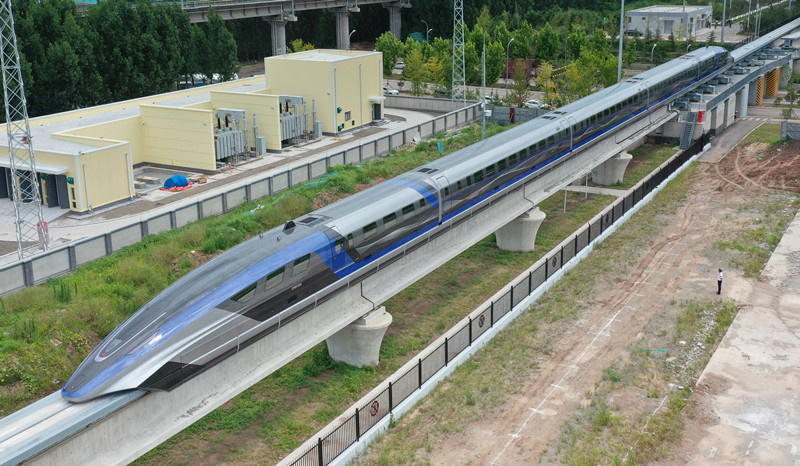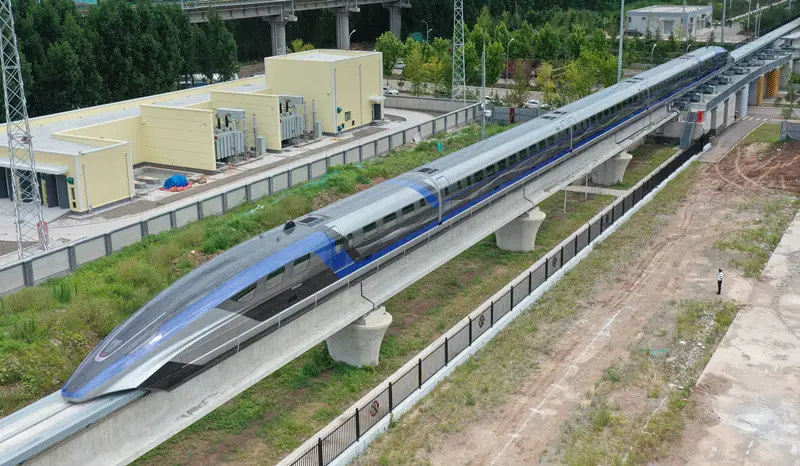By Lu Yanan, People’s Daily

A high-speed maglev train with a designed top speed of 600 kilometers per hour rolls off the production line in Qingdao, east China’s Shandong province, July 20, 2021. It is the world’s first maglev transportation system that is able to run as fast as 600 kilometers per hour. (Photo by Zhang Jingang/People’s Daily Online)
The new kinetic energy index of China’s economic development in 2020 surged 35.3 percent to 440.3, said China's National Bureau of Statistics (NBS).
The new kinetic energy index, a statistical indicator system with new industries, new business formats and new business models as the main contents, is used to reflect the development trend and process of new economic momentum.
It is subdivided into network economy index, economic vitality index, innovation driven index, knowledge capability index, as well as transformation and upgrading index.
In 2020, the new kinetic energy index of China’s economic development achieved rapid increase despite the shattering blow of the COVID-19 epidemic, which mirrored the strong resilience and vitality of the Chinese economy and greatly supported China’s high-quality economic development, said Lyu Haiqi, head of the statistical research institute under the NBS.
Based on the new situation and characteristics of new industries, new business formats and new business models, the statistical index system of new kinetic energy was revised and improved this time. According to the revised index system, China’s new kinetic energy indexes of economic development from 2015 to 2020 (taking that of 2014 as 100) were 119.6, 146.9, 191.2, 257.9, 325.5 and 440.3, respectively, increasing 19.6, 22.8, 30.2, 34.9, 26.2, and 35.3 percent year on year.
In 2020, all sub-indexes of new kinetic energy increased compared with the previous year, among which the network economy index grew the fastest and contributed the most to the growth of the total index.
According to the NBS, the network economy index was 1,323.6, a year-on-year increase of 54.8 percent, contributing 81.7 percent to the overall index growth.
The number of Internet users continued to grow in China. As of the end of 2020, China had nearly 1.35 billion mobile Internet users, an increase of 2.3 percent from the previous year, and 480 million fixed broadband subscriptions, up 7.6 percent year on year.
Besides, China’s mobile Internet traffic reached 165.6 billion gigabytes, 1.36 times and 80.3 times that in 2019 and 2014, respectively.
As new business formats continuously emerged, telecommuting, telemedicine, contactless delivery, and other businesses are more widely seen across the country. In 2020, Chinese e-commerce platforms registered a turnover of 37.2 trillion yuan ($5.74 trillion), an increase of 4.5 percent from the previous year.
New types of consumption saw fast growth in China last year. The country’s online retail sales totaled 11.76 trillion yuan, up 10.9 percent year on year after deducting price factors. “New online retail formats have continuously taken shape and further expanded consumption scenarios as new consumption demands appeared amid epidemic prevention and control,” Lyu pointed out.
Last year, China’s R&D expenditure accounted for 2.4 percent of the country’s GDP, up 0.16 percentage points from the previous year. The number of patents granted among every 10,000 R&D personnel reached 4,639, a significant increase of 34.6 percent compared with that in 2019 and 2.1 times that of 2014.
Besides, the amount of deals concluded in the technology market reached 2.82 trillion yuan, an increase of 26.1 percent over the previous year, signaling rapid growth of the technology market.
The value added of new industries, new business formats and new business models made up about 17.08 percent of China’s GPD last year, said Long Haibo, a researcher at the Development Research Center of the State Council, adding that new kinetic energy of China’s economic development gained momentum.
Coordinating epidemic prevention and control and economic and social development, China was the first country in the world to have resumed work and production and achieved positive economic growth, which is inseparable from the country’s implementation of its innovation-driven development strategy, Long said.
By promoting the resumption of work and production with digitization and intelligence, and making industries more digitalized and intelligent during the resumption of work and production, China is able to continuously optimize its economic structure, Long said.
Last year, China witnessed a rapid development of strategic emerging industries. The value added of the country’s strategic emerging industries accounted for 11.7 percent of its GDP, 0.2 percentage points higher than the previous year and 4.1 percentage points higher than that in 2014.
China has actively responded to the challenge brought by the epidemic, strengthened overall work planning, and introduced a series of policies and measures to support emerging industries, Lyu noted.
In particular, it has further implemented the strategy of innovative development of the industrial Internet, cultivated the integrated circuit and software industries, set up AI innovation and application pilot zones, and vigorously developed new energy vehicle industry, to promote the growth of new industries, Lyu said.
In 2020, the value added of China’s high-tech manufacturing industry increased by 7.1 percent year on year, 4.3 percentage points higher than the growth rate of the added value of industries above designated size. The proportion of the value added of high-tech manufacturing industry in that of industries above designated size rose 0.7 percentage points to 15.1 percent. The country’s high-tech manufacturing sector is becoming more clustered, informatized and intelligent.
The new kinetic energy index, a statistical indicator system with new industries, new business formats and new business models as the main contents, is used to reflect the development trend and process of new economic momentum.
It is subdivided into network economy index, economic vitality index, innovation driven index, knowledge capability index, as well as transformation and upgrading index.
In 2020, the new kinetic energy index of China’s economic development achieved rapid increase despite the shattering blow of the COVID-19 epidemic, which mirrored the strong resilience and vitality of the Chinese economy and greatly supported China’s high-quality economic development, said Lyu Haiqi, head of the statistical research institute under the NBS.
Based on the new situation and characteristics of new industries, new business formats and new business models, the statistical index system of new kinetic energy was revised and improved this time. According to the revised index system, China’s new kinetic energy indexes of economic development from 2015 to 2020 (taking that of 2014 as 100) were 119.6, 146.9, 191.2, 257.9, 325.5 and 440.3, respectively, increasing 19.6, 22.8, 30.2, 34.9, 26.2, and 35.3 percent year on year.
In 2020, all sub-indexes of new kinetic energy increased compared with the previous year, among which the network economy index grew the fastest and contributed the most to the growth of the total index.
According to the NBS, the network economy index was 1,323.6, a year-on-year increase of 54.8 percent, contributing 81.7 percent to the overall index growth.
The number of Internet users continued to grow in China. As of the end of 2020, China had nearly 1.35 billion mobile Internet users, an increase of 2.3 percent from the previous year, and 480 million fixed broadband subscriptions, up 7.6 percent year on year.
Besides, China’s mobile Internet traffic reached 165.6 billion gigabytes, 1.36 times and 80.3 times that in 2019 and 2014, respectively.
As new business formats continuously emerged, telecommuting, telemedicine, contactless delivery, and other businesses are more widely seen across the country. In 2020, Chinese e-commerce platforms registered a turnover of 37.2 trillion yuan ($5.74 trillion), an increase of 4.5 percent from the previous year.
New types of consumption saw fast growth in China last year. The country’s online retail sales totaled 11.76 trillion yuan, up 10.9 percent year on year after deducting price factors. “New online retail formats have continuously taken shape and further expanded consumption scenarios as new consumption demands appeared amid epidemic prevention and control,” Lyu pointed out.
Last year, China’s R&D expenditure accounted for 2.4 percent of the country’s GDP, up 0.16 percentage points from the previous year. The number of patents granted among every 10,000 R&D personnel reached 4,639, a significant increase of 34.6 percent compared with that in 2019 and 2.1 times that of 2014.
Besides, the amount of deals concluded in the technology market reached 2.82 trillion yuan, an increase of 26.1 percent over the previous year, signaling rapid growth of the technology market.
The value added of new industries, new business formats and new business models made up about 17.08 percent of China’s GPD last year, said Long Haibo, a researcher at the Development Research Center of the State Council, adding that new kinetic energy of China’s economic development gained momentum.
Coordinating epidemic prevention and control and economic and social development, China was the first country in the world to have resumed work and production and achieved positive economic growth, which is inseparable from the country’s implementation of its innovation-driven development strategy, Long said.
By promoting the resumption of work and production with digitization and intelligence, and making industries more digitalized and intelligent during the resumption of work and production, China is able to continuously optimize its economic structure, Long said.
Last year, China witnessed a rapid development of strategic emerging industries. The value added of the country’s strategic emerging industries accounted for 11.7 percent of its GDP, 0.2 percentage points higher than the previous year and 4.1 percentage points higher than that in 2014.
China has actively responded to the challenge brought by the epidemic, strengthened overall work planning, and introduced a series of policies and measures to support emerging industries, Lyu noted.
In particular, it has further implemented the strategy of innovative development of the industrial Internet, cultivated the integrated circuit and software industries, set up AI innovation and application pilot zones, and vigorously developed new energy vehicle industry, to promote the growth of new industries, Lyu said.
In 2020, the value added of China’s high-tech manufacturing industry increased by 7.1 percent year on year, 4.3 percentage points higher than the growth rate of the added value of industries above designated size. The proportion of the value added of high-tech manufacturing industry in that of industries above designated size rose 0.7 percentage points to 15.1 percent. The country’s high-tech manufacturing sector is becoming more clustered, informatized and intelligent.
 Menu
Menu
 New kinetic energy of China’s economic development gains momentum
New kinetic energy of China’s economic development gains momentum
















